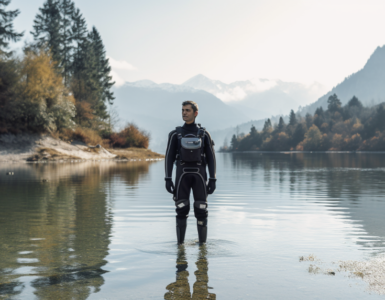Ever wondered what to wear under your wetsuit? You’re not alone! This question is one that many new and even some experienced watersport enthusiasts grapple with. But why does it matter? Well, choosing the right undergarments for your wetsuit can make a significant difference in both your comfort and safety when engaging in water activities. This guide will help you understand the importance of what you wear under your wetsuit and how to make the best choice for your needs.
The Basic Principles of Wetsuit Undergear
When it comes to choosing what to wear under your wetsuit, there are a few basic principles to keep in mind. First and foremost, the undergarments should provide warmth. A wetsuit works by trapping a thin layer of water between your body and the suit, which your body then heats. The right undergarments can enhance this insulation effect.
Secondly, flexibility is key. You don’t want your movements to be restricted by bulky or tight undergarments. Lastly, you want to avoid chafing. This can be achieved by choosing materials that are soft and smooth against your skin.
Why What You Wear Under Your Wetsuit Matters
So, why does it really matter what you wear under your wetsuit? The answer lies in the practical implications. For starters, the right undergarments can significantly improve temperature regulation, helping you stay warm in cold water and cool in warm water. This not only enhances your comfort but also your safety, as it can prevent hypothermia in cold conditions.
Furthermore, the right undergarments can prevent chafing, which can cause discomfort and even lead to skin infections if left unattended. Lastly, they can enhance your overall comfort, making your watersport experience more enjoyable. After all, who wants to be distracted by uncomfortable undergarments when they’re trying to catch a wave or explore underwater?
Choosing the Right Underwear for Your Wetsuit
Ever wondered what the best undergarments to wear under a wetsuit are? The answer largely depends on the water temperature you’re going to be in.
For Warm Waters
When diving or surfing in warm waters, the key is to stay cool and avoid chafing. The best choices are lightweight, quick-drying undergarments. Consider materials like nylon or lycra, which are not only light but also have the added advantage of quick drying.
Choosing the right fit is also essential. You want something that fits snugly but not too tightly. Think about it: you don’t want to be adjusting your undergarments while you’re riding a wave, do you?
For Cold Waters
When it comes to cold waters, the game changes. Here, insulation is crucial. You want undergarments that will keep you warm while also wicking away any moisture.
Materials such as neoprene or thermal synthetic fabrics are excellent choices. They provide the necessary insulation while also being flexible and stretchy enough to not restrict your movements. Remember, the goal is to stay warm without sacrificing comfort or flexibility.
Special Considerations for Women
For the ladies, there are a few additional considerations to keep in mind. For instance, a good sports bra can make a world of difference in terms of comfort and support.
Furthermore, many women prefer to wear swimsuits under their wetsuits. This is a viable option, especially when the swimsuit is made of a material that is comfortable and quick-drying. Just ensure the swimsuit isn’t too loose or too tight to prevent any discomfort.
At the end of the day, what matters is your comfort and safety. Choose undergarments that not only meet your needs but also make you feel confident and comfortable in your wetsuit.
Materials to Consider and Those to Avoid
So, what should you wear under your wetsuit? It’s all about the materials. Certain materials are more suitable for wetsuit undergarments than others due to their unique properties. Let’s dive in!
Firstly, synthetic fibers such as polyester, nylon, or spandex are excellent choices. They are lightweight, durable, and quick-drying. More importantly, they retain less water, which is crucial when you’re submerged in water. Lastly, they offer excellent flexibility, which allows for a full range of motion when indulging in water sports.
On the other hand, cotton should be avoided at all costs. While it might be comfortable and breathable on land, cotton absorbs a lot of water and takes longer to dry. This can lead to discomfort, and in colder conditions, hypothermia. Remember, the goal is to stay warm and comfortable. So, it’s best to stick with synthetic materials for your wetsuit undergarments.
| Material | Pros | Cons |
|---|---|---|
| Polyester | Lightweight, Durable, Quick-drying | Not as breathable as other materials |
| Nylon | Strong, Resistant to abrasion, Quick-drying | Can be a bit stiff, Less breathable |
| Spandex | Extremely flexible, Fits well | Not as durable, Can lose shape over time |
| Cotton | Comfortable, Breathable | Absorbs a lot of water, Takes longer to dry |
Common Myths About What to Wear Under a Wetsuit
There are numerous misconceptions about what to wear under a wetsuit. Let’s debunk a few of these myths, shall we?
- Myth: You don’t need to wear anything under a wetsuit. Fact: While some people may choose to wear nothing, this can lead to discomfort, chafing, and other issues. It’s typically best to wear a synthetic undergarment.
- Myth: Cotton is the best material for undergarments. Fact: As mentioned earlier, cotton absorbs a lot of water and takes longer to dry, making it unsuitable for wetsuit undergarments.
- Myth: You can’t wear swimsuits under a wetsuit. Fact: Swimsuits, particularly those made of synthetic materials, can be an excellent choice for wetsuit undergarments.
- Myth: The tighter the undergarment, the better. Fact: While you don’t want loose undergarments that can bunch up, too-tight undergarments can limit mobility and be uncomfortable.
Tips for Dressing and Undressing With a Wetsuit On
Ever struggled with getting in and out of a wetsuit? Trust me, you’re not alone. This can be a bit of a challenge, especially when you’re new to watersports. But don’t worry, we’ve got you covered with these tips.
Firstly, it’s crucial to be gentle. Wetsuits are quite durable, but they can be damaged by rough handling. So, avoid pulling too hard or fast. Instead, gradually work the suit up your body, bit by bit.
Secondly, use plastic bags or gloves. Sounds weird, right? But putting a plastic bag over your foot or hand can make sliding into your wetsuit much easier. This trick reduces friction and helps protect both your wetsuit and undergarments.
Lastly, remember to fully unzip the wetsuit before trying to take it off. This might seem obvious, but in the excitement of a great dive or surf, it’s easy to forget. Unzipping fully will make the process much smoother.
Final Recommendations for Wetsuit Undergarments
Now that we’ve covered the ins and outs of what to wear under a wetsuit, let’s summarize with some final recommendations.
- Synthetic materials are your best friend. They offer flexibility, quick-drying properties, and resistance to chafing.
- Avoid cotton undergarments. They absorb water, get heavy, and lose their insulation properties when wet.
- Choose your undergarments based on the water temperature. Light, quick-drying options for warm waters and insulating materials for colder waters.
Remember, the right wetsuit undergarments can make all the difference in your watersport experience. They keep you comfortable, reduce chafing, and help regulate your body temperature. So why compromise?
To wrap up, investing in the right undergarments for your wetsuit is not just about comfort, it’s also about safety. Because, at the end of the day, isn’t a safe and comfortable watersport experience what we all want?




